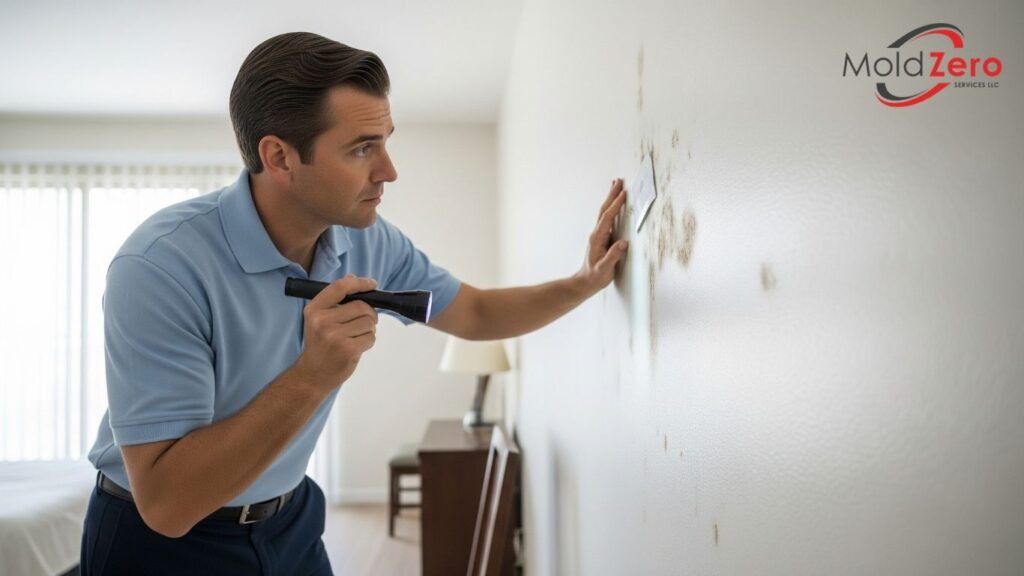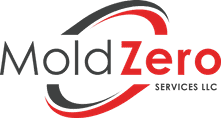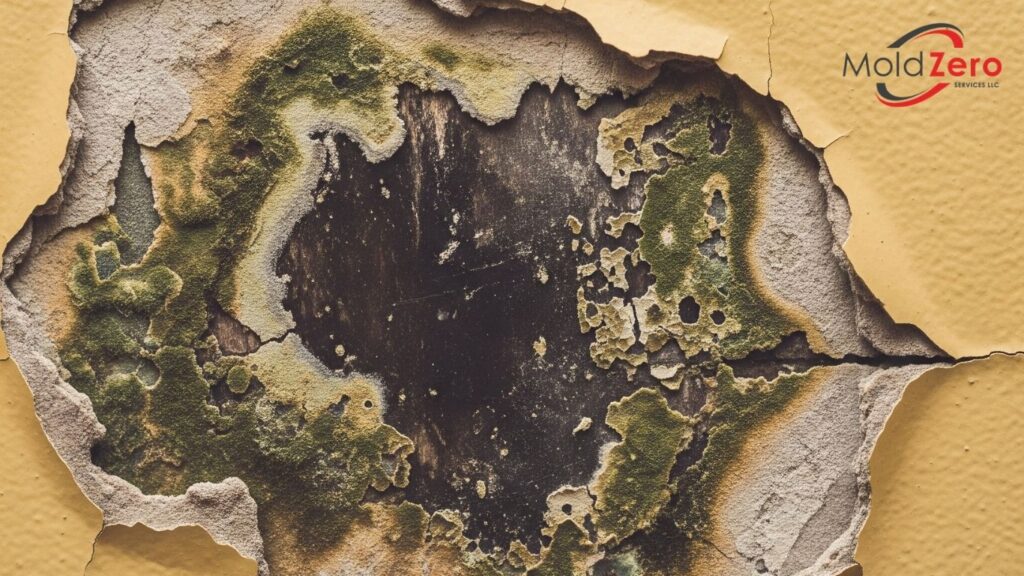10 Hidden Signs of Water Damage You Might Be Missing
As a Los Angeles homeowner, you work hard to maintain your property. While obvious issues like a burst pipe are impossible to ignore, water damage often starts subtly, with hidden signs that can easily be overlooked. If not caught early, this concealed moisture can lead to significant problems, including structural issues and, a common consequence, mold growth. Protecting your home means being vigilant for even the most inconspicuous clues.
At Mold Zero, we want to help you identify these early warnings. Recognizing hidden water damage promptly is crucial for safeguarding your Los Angeles home, preserving its value, and maintaining a sound indoor environment.
Why Hidden Water Damage is a Serious Concern for Your LA Home
The primary concern with any water damage, hidden or overt, is its potential to create the perfect breeding ground for mold. Mold needs moisture to thrive, and areas of undetected dampness offer an ideal habitat. According to FEMA (Federal Emergency Management Agency), mold can begin to grow on a damp surface within just 24 to 48 hours. Beyond mold, persistent hidden water damage can also:
- Weaken wooden structures and framing.
- Cause drywall to crumble and paint to peel.
- Damage flooring and cabinetry.
- Potentially affect the quality of your indoor air.
Early detection and intervention are your best defense.

10 Hidden Signs of Water Damage You Shouldn’t Ignore in Your Home
Keep an eye out for these subtle indicators that could signal a hidden water issue in your home in Los Angeles:
1. Persistent Musty or Earthy Odors
If you notice a lingering musty, damp, or earthy smell, especially in specific rooms or areas, and there’s no obvious source, it’s a classic sign of hidden moisture and potential mold growth somewhere nearby – perhaps behind walls, under flooring, or in a crawl space.
2. Localized Discoloration or Faint Stains
Not all water stains are large and dark brown. Look for subtle discoloration, faint yellowing, or map-like lines appearing on ceilings or walls. Pay close attention to areas near windows, in corners, along baseboards, or under sinks. These can indicate a slow leak or condensation issue.
3. Peeling, Bubbling, or Cracking Paint or Wallpaper
Moisture trapped behind paint or wallpaper will eventually cause it to detach from the surface. If you see paint that’s bubbling, blistering, peeling, or cracking, or wallpaper that’s loose or showing seam separation, hidden dampness in the wall is a likely culprit.
4. Warped, Buckling, or Soft Spots in Walls, Ceilings, or Floors
Drywall, plaster, and wood absorb moisture, causing them to swell, warp, or soften. Gently press on suspicious areas. If a wall or ceiling feels soft, spongy, or looks bowed, it’s a strong indication of underlying water damage.
5. Changes in Your Flooring
Different flooring types show water damage in various ways:
- Loose Tiles: Grout may crack or tiles may become loose if the subfloor is damp.
- Hardwood Issues: Look for cupping (edges higher than the center), crowning (center higher than edges), buckling, or unexplained gaps appearing between planks.
- Damp or Stained Carpet: If carpet feels damp to the touch or shows unusual discoloration with no known spill, moisture could be wicking up from below.
6. Unexpected Increase in Your Water Bill
If your water bill suddenly spikes without a corresponding increase in your household’s water usage, you might have a hidden plumbing leak somewhere in your system. Comparing current bills to previous months can help spot this.
7. Faint Sounds of Dripping or Running Water
When all taps and water-using appliances are off, listen carefully. If you hear faint dripping, hissing, or running water sounds within walls, under floors, or in the ceiling, it could be an active leak that needs immediate attention.
8. Excessive or Persistent Condensation
While some window condensation is normal in certain conditions, excessive or persistent condensation on windows, pipes, or even walls can indicate high indoor humidity levels or cold surfaces where moisture is consistently collecting – both of which can support mold growth.
9. Efflorescence (White, Powdery Substance)
If you notice a white, chalky, or crystalline substance appearing on masonry, concrete, brick, or stucco surfaces (common in basements, foundations, or even some exterior walls in Los Angeles), this is efflorescence. It’s caused by water seeping through these materials, dissolving salts, and then evaporating, leaving the salt deposits behind – a clear sign of moisture movement.
10. Unexplained Pest Problems
Certain pests are drawn to moist environments. An unusual increase in cockroaches, silverfish, carpenter ants, or even rodents could indicate that there’s a damp area somewhere in your home that’s attracting them.
What to Do When You Spot These Hidden Signs of Water Damage
Discovering one or more of these subtle signs warrants further action. Don’t delay your investigation, as early intervention can save you significant trouble and expense.
- Try to Identify the Source: If possible and safe, try to determine where the moisture is coming from. Is it near a bathroom, kitchen, appliance, or an exterior wall?
- Act Quickly on Visible Water: If you find active water, take steps to stop it if you can (e.g., shut off the local water valve) and dry the area immediately.
- Know When to Call Professionals: For minor, easily identifiable issues with an obvious source you can fix, a DIY approach might be possible for the repair itself. However, if the source is hidden, if the damage seems potentially widespread, or if you suspect mold has already started to grow, it’s crucial to call professionals.
At Mold Zero, we offer comprehensive and free mold inspections for Los Angeles homeowners. Our expert technicians can help pinpoint hidden moisture sources, assess the extent of any water damage, and determine if mold growth is present.
How Mold Zero Addresses Water Damage and Resulting Mold in Los Angeles Homes
If our inspection confirms water damage and associated mold, Mold Zero provides thorough and effective solutions:
- Thorough Assessment: We don’t just look at the visible signs; we investigate to understand the full scope of the issue.
- Effective Mold Remediation: Our mold remediation services are designed to address the mold while also helping you understand the importance of correcting the underlying moisture problem. Our 5-step process is minimally invasive and highly effective.
- Addressing All Types of Mold: Prolonged water damage can lead to various types of mold. We are experienced in handling all situations, including those involving concerns about black mold.
- Expertise for Any Scale: Our extensive experience, which includes handling large and complex commercial mold removal projects, means we bring a high level of skill and knowledge to every residential property, ensuring quality and thoroughness.
Protecting Your Los Angeles Home Starts with Vigilance
Being observant and attuned to these subtle signs of water damage is one of the most important things you can do as a Los Angeles homeowner. Early detection and prompt action are key to preventing minor issues from escalating into major structural problems and significant mold growth.
If any of these hidden signs resonate with what you’re seeing in your home, don’t hesitate to seek professional advice.
Contact Mold Zero Services LLC today at (626) 671-8885 or fill out our online form to schedule a free, no-obligation inspection and quote. We’re here to help you protect your Los Angeles home from the hidden threats of water damage and mold.

